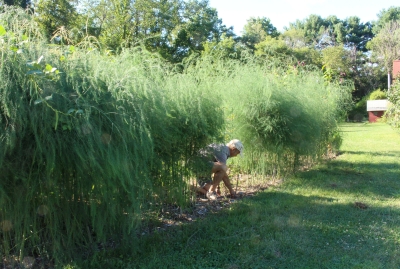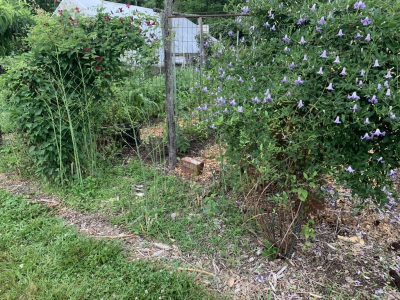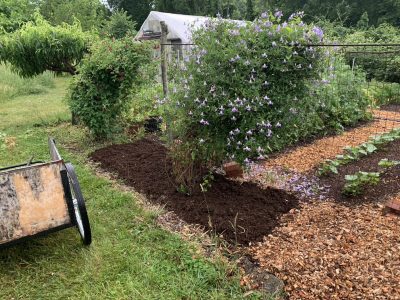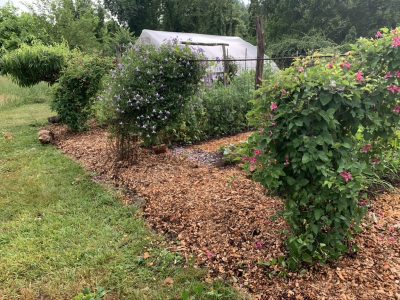“SPARROWGRASS” RENOVATION
The Season Ends
Asparagus season has ended here now, after more than two months of harvest. From now till they yellow in autumn, the green fronds will gather sunlight which, along with nutrients and water, will pack away energy into the roots, energy that will fuel next year’s harvest.

In addition to dealing with the weather, the plants have to contend with weeds. I have to admit, despite being the author of the book Weedless Gardening, that my asparagus bed each year is overrun with weeds, mostly two species(!) of oxalis, creeping Charlie, and various grasses. Also weeds parading as asparagus, self-sown plants. This, even though I planted all male varieties. Any batch of male plants typically has a certain, low percentage of female plants. (Still, my garden is weed-less even if it’s not weedless.)
I always wondered about the recommendation to plant asparagus crowns in deep trenches that are gradually filled in with soil as the new plants grow. I read that one reason is that crowns deep in the soil results in thicker, albeit fewer and later, spears. But as if to decide for themselves, research also shows that , over time, shallowly planted crowns naturally settle deeper into the ground, and deeply planted crowns inch upwards.

Another reason for deep planting is, perhaps, to protect the crown from tiller blades or hoes. I don’t till and, since the plants anyway take the matters in their own hands, I set my asparagus, years ago when I planted them, just deep enough to get the crowns under the ground.
Weed Control(?) for Next Year
But back to the weeds in my asparagus bed . . . This year I’m determined to get more of the upper hand with weeds. To whit: Yesterday I cut everything — weeds and asparagus — in the bed as low as possible. A bush scythe, which is a scythe with a short, heavy duty blade, does this job easily and quickly; a weed whacker might also work. One year a battery powered hedge trimmer got the job done. For me, the scythe works best.
In years past, I would cut everything to the ground, as I did this year, and then I’d top the bed with a couple of inches of wood chips.
This year, to get better weed-less-ness and to offer the asparagus plants a treat as thanks for the many spears that went into cold soup, hot vegetable dishes, and the freezer, I offered them compost. Although I make lots of compost, that compost is generally reserved for beds within the vegetable garden proper and potting mixes as well as, this year, my newly planted grape vines, and pear and apple trees.

Asparagus is worth it, so I dug into my most finished compost bin, filled up two garden carts, and slathered a one-inch layer of compost over the whole bed. That inch of dense, dark compost should go a long way to smothering small weeds, which have little reserve energy. The compost then got topped with a couple of inches of wood chips.  The compost will nourish the asparagus . . . and the weeds, most of which I hope will be sufficiently young or weakened to not push up through the compost and the wood chips to light.
The compost will nourish the asparagus . . . and the weeds, most of which I hope will be sufficiently young or weakened to not push up through the compost and the wood chips to light.
Compost Needed
That was a lot of compost to part with. No problem, because I’ve also been making lots of compost. Plus, a few bins I built last year, each with about one-and-half cubic yards of compost, are ready to use or will be so in the coming weeks.
The bins themselves are made from 1×6 boards of composite wood (a mixture of waste wood, recycled and new plastic, and some type of binding agent), such as used for decking, notched to stack together Lincoln-log style. It keeps moisture and heat in, and scavengers and weeds more or less out, and doesn’t degrade, as did my previous wood bins.
I feed my compost pets — earthworms, fungi, bacteria, and other organisms — hay from my small field, manure from a nearby horse farm, kitchen waste, old garden plants, and anything else biodegradable. The latter category has included old leather shoes and garden gloves, jeans, and, as an experiment, biodegradable(?) plastic spoons.
The compost also gets occasional sprinklings of soil, to add bulk, and ground limestone. Periodic liming is generally needed to counteract the acidity of most soils of northeastern U.S.; my soil gets limed indirectly, via the compost.

Water is commonly the most limiting ingredient in home composts. Lots of water is necessary to percolate down into a pile. Rather than getting bored with a hose wand, after finishing an extended composting session, I set up a small sprinkler on the pile, whose spread is as wide as the pile, to gently water for about 20 minutes.
Of course, the devil is in the details: how much of each ingredient to add. Not to worry, though. Any pile of organic materials will eventually turn to compost.
For my piles, I check moisture with a REOTEMP long stem moisture meter and monitor progress with a long stem compost thermometer. This time of year temperatures of the piles soar to 150°F within a few days.
My asparagus bed is worth all this.


Hi Lee,
I just want to let you know that I appreciate you and all that you have done to teach me lots of things about gardening (though you may not know that!). Anyhow, I’m confused with your asparagus post. Are you saying that you cut the fronds down and didn’t let them gather energy for the remainder of the summer? I always thought that they needed to stay “ferny” to gather energy until the fall. Thanks for clarification!
I cut down all the fronds whenever I harvest until July 1. So I just did it once more, mulched, And now I’ll let the fronds grow until they die back in the fall. Many have already popped up to the layer of compost and mulch.
I understand now. Thanks Lee!
Clemson Extension says to not cut or gather some of the hills of asparagus, let them go to fronds & gather energy into the roots & cut the fronds after all other asparagus has went to fronds in late summer,in south Carolina that is 2nd week in July.At that time cut all the fronds down & gather the spears as if it was Spring, after normal gathering(2-4 weeks) , let the fronds grow again until the frost kills them. This will give you fresh spear for a longer time & will not harm next years crop.
I have read, sorry do not know where, that the french buried the crowns 12 inches deep, to get white spears & that is the only reason for the myth that you have to bury crowns. I am not sure where it came from & I bury mine six inches deep in a perennial bed, mulch with leaves. In ten years I have not lost any crowns.
Instead of deep planting, those French gardeners also sometimes get white spears by hilling up soil around the plants to blanche them. Quelle charmante.
“Yesterday I cut everything — weeds and asparagus — in the bed as low as possible.”
Wait. What?! You cut the green fronds? It seems every piece I read online by an university extension indicates fronds should be left to die back naturally. Is the thought that the compost you apply compensates for the lost of energy harvested from the sun?
If that’s the logic, how confident are you that it works in the long run? Also, in the absence of sufficient compost, do you think a combination of soybean meal and grass clippings as a mulch would work as well?
Thanks for the timely post. I was about to venture back into my asparagus bed today on hands and knees to weed, but your post has given me pause.
I cut down all the fronds whenever I harvest until July 1. So I just did it once more, mulched, And now I’ll let the fronds grow until they die back in the fall. Many have already popped up to the layer of compost and mulch.
The problem with grass clippings is you would have to put it on very thick to smother all the weeds. But when clippings are layered that thickly, the heat up and also form an almost impenetrable barrier.
Lee, Its ok to cut the asparagus ferns down to the ground this time of year? It would make it easier getting to the weeds.
Thank You
Gerard
I cut down all the fronds whenever I harvest until July 1. So I just did it once more, mulched, And now I’ll let the fronds grow until they die back in the fall. Many have already popped up to the layer of compost and mulch.
Thank you, Lee❣️—From Toni on Mossy Brook.
Did I read correctly? You cut down the asparagus fronds to the ground now? I thought they were gathering nutrients for next years spears. Will cutting the fronds now diminish next years harvest?
I cut down all the fronds whenever I harvest until July 1. So I just did it once more, mulched, And now I’ll let the fronds grow until they die back in the fall. Many have already popped up to the layer of compost and mulch.
I’m confused. I thought it was necessary to wait for the cross to die back before cutting them and mulching the bed. Your post makes it sound as though you have already cut them this year.
I cut down all the fronds whenever I harvest until July 1. So I just did it once more, mulched, And now I’ll let the fronds grow until they die back in the fall. Many have already popped up to the layer of compost and mulch.
Will you take me on a tour in your garden Lee ?
How?
Hi Lee,
I have jersey knight asparagus plants from raintree nursery, 4 years old. I’m going to move them to a better situation. Shall I shift them in fall or spring?
Thank you.
Leslee
I’m a big fan of fall planting.
Thank you.
It’s now on the September calendar of ‘things to do’.
Possibly October, depending on where you are.
This question comes up on Gardeners’ Question Time regularly and the answer from all of the panelists (save, perhaps, Bunny Guinness) is that asparagus cannot be moved once established. The roots are too extensive, so it’s virtually impossible to move them without causing significant damage.
If the current bed is untenable and you’re going to trash it anyway, then there’s probably no harm in giving it a try, but you want to ensure you get a reasonable yield, you may be better off starting with new crowns or from seeds depending on how much patience you have.
I agree, except that any plant can be moved if taken with enough dirt and roots. (A variation of Archimedes’ assertion that, given a long enough lever, he could move the earth.) Yes, starting with new crowns or seeds is probably wiser or, at least, easier.
After cutting back your asparagus and spreading the compost. do you continue watering the asparagus bed?
Asparagus has very far-reaching roots so I decided to completely stop watering them a couple of years ago. (Also, the puppy had chewed up the drip irrigation line in the bed.) All that mulching really helps also.
Thanks for this mind blowing advice re asparagus. I planted Jersey Knight in a community garden 7 years ago. Wish I had know about asparagus beetles not hanging around in July earlier but they were a problem only one year. Mine are planted in a raised bed that is 4X10 and I dug it nearly 3 ft down filling the bottom with lots of home made compost and leaf mould and added super phosphate as advised by experienced community gardeners. To my amazement the soil looked great all the way down. I have always topped it up with at least an inch of compost or leaf mould and then wood chips or sometimes pine fines which has prevented any weeds> The rules have changed and this year asparagus is considered too tall for the community garden. I want to move the roots to my home garden. When best to move? I would prob be able to do it after cutting down the fronds in November. What do you consider ideal spacing?
A November move would be good. Spacing? My guess is about 18″ but I suggest you just look up the recommended spacing. By the way, I would recommend against digging down three feet to plant asparagus as well as putting compost and leaf mold in the bottom of the hole.